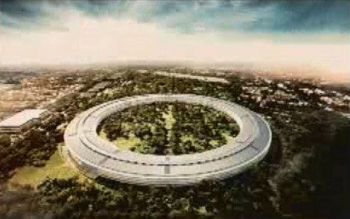Apple Plans Hiring Spree For Spaceship Campus

Apple has revealed plans to hire up to 7,400 new staff as it files documents for its new ‘spaceship’ campus
Apple has shrugged off any impression of corporate struggles after it posted a report on the expected impact of its second corporate campus.
Indeed, for a notoriously secretive company, the document is revealing, especially as it comes at a time when Apple is experiencing something of a reputation blemish.
Apple Plans
The plans suggest a resounding brand booster, describing Apple as a “cornerstone” of its local economy and suggesting that, with plans to hire 7,400 new employees over the next three years, the company has no question about its ability to grow and compete against Samsung.
 In June 2011, months before losing his battle with pancreatic cancer, former Apple CEO Steve Jobs introduced Apple’s expansion plans, which includes a 176-acre plot and a circular, four-story building that can hold 12,000 people.
In June 2011, months before losing his battle with pancreatic cancer, former Apple CEO Steve Jobs introduced Apple’s expansion plans, which includes a 176-acre plot and a circular, four-story building that can hold 12,000 people.
“It’s a pretty amazing building,” Jobs said at the time. “It’s a little like a spaceship landed.”
Apple’s current campus accommodates 3,000 employees; for the 13,000 employees it doesn’t fit, Apple has leased or purchased work sites in and around Cupertino, California The new campus would, among many other things, make for a literally more united company.
While local government officials have been generally supportive of the plan, they requested more information, and so Apple turned to Keyser Marston Associates to compile the report.
According to Keyser Marston, Apple is the second largest employer in Silicon Valley and the largest employer in the city of Cupertino.
In addition to its 16,000 employees, Apple indirectly generates 12,100 jobs in Santa Clara County. By the time its Campus 2 is available for occupancy (build time has been slated for three years), Apple will be behind approximately 24,000 jobs in Cupertino and 41,000 jobs in Santa Clara County, says the report.
Apple paid out $2 billion (£1.3bn) in employee salaries in 2012 and expects that figure to near $3 billion (£1.95bn) upon completion of Campus 2. And, lest anyone think that Apple doesn’t pay taxes, the report states that in fiscal year 2012/2013, Apple will contribute $9.2 million (£6m) in taxes to the city, “which accounts for approximately 18 percent of the City of Cupertino’s annual General Fund Budget.”
Apple additionally generated $6.5 million (£4.2m) in sales tax in Cupertino during 2012, which represented 45 percent of the sales tax revenue the city received, and it paid $25 million (£16m) in property taxes; Apple Campus 2 is expected to add $32 million (£21m) to Apple’s property tax bill.
Apple Concerns?
Continuing to toot Apple’s horn, the report states that Apple “has experienced extraordinary success and growth by any standard.” Between 2006 and 2012 it grew sixfold and had an annual growth rate in excess of 36 percent.
During its last fiscal quarter, however, Apple posted a profit slip, its first in a decade, despite selling 37.4 million iPhones and 19.5 million iPads. CEO Tim Cook blamed the decline on an “incredibly weak” PC market, people extending their upgrade cycles and iPads to some degree cannibalising some Mac sales.
There can be no doubt of Apple’s success. But the profit slip joined a growing number of instances – from its poor Maps application to human rights issues at its partner’s factories to allegations of avoided taxes – in which Apple, which prides itself on perfection, has been portrayed as falling shy of that goal.
In late 2012, Apple made adjustments to its Campus 2 proposal and pushed the move-in date from 2015 to the current timeframe of mid-2016.
“The project is running a little bit slow,” David Brandt, Cupertino’s city manager, told Bloomberg at the time. “There’s nothing super-significant,” he added. “I think they are just constantly trying to improve the project.”
What do you know about the iPhone? Find out with our quiz!
Originally published on eWeek.